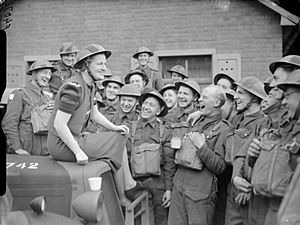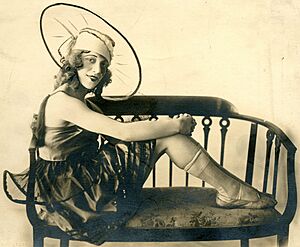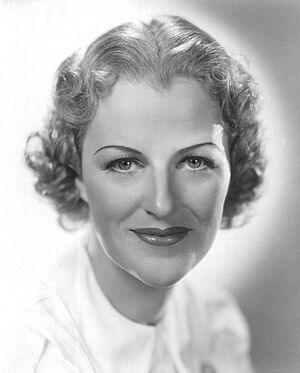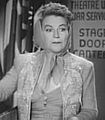Gracie Fields facts for kids
Quick facts for kids
Gracie Fields
|
|
|---|---|

Fields on Capri (Allan Warren, 1973)
|
|
| Born |
Grace Stansfield
9 January 1898 Rochdale, Lancashire, England
|
| Died | 27 September 1979 (aged 81) La Canzone Del Mare, Capri, Italy
|
| Nationality | British/Italian |
| Occupation |
|
| Years active | 1910–1979 |
| Spouse(s) |
Archie Pitt
(m. 1923; div. 1939)Monty Banks
(m. 1940; Boris Alperovici
(m. 1952) |
Dame Gracie Fields (born Grace Stansfield; 9 January 1898 – 27 September 1979) was a famous English actress, singer, and comedian. She was a big star in movies and on stage, especially in music hall shows. In the 1930s, she was one of Britain's top film stars. In 1937, she was even thought to be the highest-paid film star in the world! People lovingly called her Our Gracie or the Lancashire Lass. She was known for keeping her strong accent from Lancashire, England. She received important awards for her work and charity, becoming a Dame in 1979.
Contents
Life and Work
Early Life and Stage Beginnings
Gracie Fields was born Grace Stansfield in Rochdale, Lancashire, England. Her family lived above a fish and chip shop owned by her grandmother. Gracie started performing on stage as a child in 1905. She joined children's theatre groups like "Haley's Garden of Girls."
Gracie's two sisters, Edith and Betty, and her brother, Tommy, also became performers. But Gracie was the most successful. She made her professional debut in 1910 at the Rochdale Hippodrome theatre. She soon left her job at a local cotton mill, where she worked part-time. Early newspaper stories called her "The Girl with the Double Voice."
Gracie met comedian and show producer Archie Pitt. They started working together, and he became her manager. They got married in 1923. Their first show together was Yes I Think So in 1915. They toured Britain until 1924, performing in many popular shows.
Archie Pitt's brother, Bert Aza, ran a talent agency. Gracie introduced the actor Stanley Holloway to Bert. Gracie and Stanley later worked together in her film Sing As We Go in 1934. They remained close friends for their whole lives.
Rising to Fame
Gracie Fields became very famous after her show Mr Tower of London in London's West End. Her career took off from there. She started making records with His Master's Voice (HMV). Her first record, My Blue Heaven, sold 500,000 copies in 1928. By 1933, HMV had produced four million of Gracie's records.
At one point, Gracie was performing three shows a night in London's West End. She also acted in a play called SOS.
Gracie's most famous song, "Sally", became her signature tune. She sang it in her first film, Sally in Our Alley (1931), which was a huge hit. She made several more films, first in Britain and later in the United States. She was paid a lot of money for her American films. However, Gracie didn't really enjoy making movies. She preferred performing live for an audience.
The director Monty Banks convinced her to keep making films. She got a great deal in Hollywood but insisted her films be made in Britain. Gracie often joked that she wanted to "Drown blasted Sally!" This was a funny reference to her other popular songs, "Walter, Walter" and "The Biggest Aspidistra In The World".
A famous opera singer, Luisa Tetrazzini, once heard Gracie sing an opera song. She asked Gracie to sing in grand opera. But Gracie decided to stay where she felt she belonged, performing for everyone.
Helping Others: Charity Work
In the 1930s, Gracie was very popular and received many honours. She became an Officer of the Venerable Order of St John (OStJ) for her charity work. She also became a Commander of the Order of the British Empire (CBE) for her services to entertainment in 1938. In 1937, she was given the Freedom of the Borough of Rochdale.
After her marriage ended, she gave her large house in London to an orphanage. In 1939, Gracie became very ill. People sent her over 250,000 messages of support. She went to her villa on Capri to rest. After she got better, she recorded a special message called Gracie's Thanks. In it, she thanked the public for their kindness.
Gracie also helped her local football team, Rochdale Association Football Club, in the 1930s. They were having trouble paying for things and buying equipment.
In 1933, she started the Gracie Fields Children's Home and Orphanage in Peacehaven, Sussex. This home was for children of theatre workers who couldn't look after them. Gracie kept the home until 1967. She often visited the children, who called her 'Aunty Grace'.
World War II Efforts


When World War II began in 1939, Gracie was still recovering from her illness. But she quickly joined the Entertainments National Service Association (ENSA). She traveled to France to entertain soldiers, even performing in dangerous, war-torn areas. She sang on the backs of open trucks. During the war, she also paid for all servicemen and women to travel for free on public transport in Rochdale.
In 1940, Gracie married Italian-born film director Monty Banks. Because Monty was an Italian citizen, he might have been held in the UK during the war. So, Gracie moved with him to North America. It's said that Winston Churchill even suggested she go to "Make American Dollars, not British Pounds." She did this to help raise money for the Navy League and the Spitfire Fund.
They moved to Santa Monica, California. Gracie sometimes returned to Britain to perform in factories and army camps. Even though she spent much of the war entertaining troops outside Britain, her popularity at home decreased for a while. She performed for Allied troops in many places, including New Guinea and the South Pacific Islands.
After the War
After World War II, Gracie continued her career, but less actively. She started performing in Britain again in 1948. She was the main act at the London Palladium, even over Ella Fitzgerald. The BBC gave her a radio show in 1947 called Our Gracie's Working Party. In this show, Gracie visited 12 towns, performing live music and entertainment with local talents. The tour started in her hometown of Rochdale.
In 1951, Gracie performed at the closing ceremony of the Festival of Britain. She became popular again, though not as much as in the 1930s. She kept recording music, including new versions of her old songs. She also recorded new types of music as tastes changed.
Her husband, Monty Banks, passed away in 1950. In 1952, Gracie married Boris Alperovici, a radio repairman, in Capri. She said he was the love of her life. They married quietly and then honeymooned in Rome.
Gracie lived on her beloved Isle of Capri for the rest of her life. Her home, La Canzone Del Mare, overlooked a swimming and restaurant complex. Many Hollywood stars, like Richard Burton and Elizabeth Taylor, visited there in the 1950s.
Later Years and Final Performances
Gracie started working less but still toured the UK. Her tours were very popular. In the mid-1960s, she performed farewell tours in Australia, Canada, and America. Her last performance was recorded and released years later.
In 1956, Gracie was the first actress to play Miss Marple on TV. This was in a US television show based on Agatha Christie's A Murder is Announced. She also starred in other TV productions, earning an EMMY Award nomination for her acting.
In 1957, her song "Around the World" reached No. 8 in the UK music charts. Her recording of "Little Donkey" reached No. 20 in 1959.
Gracie was featured on the TV show This Is Your Life in 1960. She often appeared on TV, being the first entertainer on Sunday Night at the London Palladium. She had two Christmas TV specials in 1960 and 1961. In 1971, she had another TV special called A Gift For Gracie. She was also the most requested artist on the religious TV show Stars on Sunday.
In 1968, Gracie performed at the Batley Variety Club. She joked, "I was born over a fish and chip shop – I never thought I'd be singing in one!" In 1975, her album The Golden Years reached No. 48 in the UK charts.
In 1978, she opened the Gracie Fields Theatre in her hometown of Rochdale. She performed a concert there to open the theatre. Gracie performed in ten Royal Variety Performances. Her last one was in 1978, at age 80. She was a surprise guest and sang her theme song, "Sally."
Her last TV appearance was in January 1979 on The Merv Griffin Show in America. She sang "The Biggest Aspidistra in the World". While in America, she learned that Queen Elizabeth II wanted to make her a Dame Commander of the Order of the British Empire. She happily accepted. Seven months before she passed away in 1979, the Queen officially made her a Dame.
Death
Gracie's health got worse in July 1979 after she performed an outdoor concert. She passed away on 27 September 1979. She is buried in Capri's Protestant Cemetery in a white marble tomb.
Honours and Legacy
Gracie Fields was made a Commander of the Order of the British Empire in 1938. In February 1979, she became a Dame Commander of the Order of the British Empire.
She was a mystery guest on the TV show What's My Line? in 1955. Gracie was also given the Freedom of Rochdale. The local theatre in Rochdale, the Gracie Fields Theatre, was opened by her in 1978.
After her death, Gracie was mentioned in several films, including Wish You Were Here (1987) and The History Boys (2006). Her songs have been performed as tributes, for example, by Marti Webb and Su Pollard.
In 2009, a train was named in her honour in England. In 2016, a statue of Gracie Fields was unveiled outside Rochdale Town Hall. This was the first statue of a woman in Lancashire in over a century.
A TV movie about her life, called Gracie!, was made in 2009. It showed her career before World War II and how her popularity changed during the war.
Notable Songs
- "We're All living at the Cloisters"
- "You Didn't Want Me When You Had Me"
- "Sally"
- "The Kerry Dance"
- "Sing As We Go"
- "Thing-Ummy-Bob (That's Gonna Win The War)"
- "The Biggest Aspidistra in the World"
- "Three Green Bonnets"
- "I Took my Harp to a Party"
- "The Trek Song"
- "Pedro the Fisherman"
- "Only a Glass of Champagne"
- "Speak Softly, Love"
- "Angels Guard Thee"
- "Around the World"
- "Nuns' Chorus"
- "Little Donkey"
- "Now Is the Hour"
- "The Carefree Heart"
- "The Isle of Capri"
- "The Woodpecker Song"
- "Walter, Walter (Lead Me to the Altar)"
- "Young at Heart"
- "Christopher Robin is Saying His Prayers"
- "Far Away"
- "If I Had a Talking Picture of You"
- "Home"
- "Wish Me Luck as You Wave Me Goodbye"
- "The Holy City"
- "When I Grow Too Old to Dream"
- "If I Knew You Were Comin' I'd've Baked a Cake"
- "The Twelfth of Never"
- "Those Were The Days" (performed live at The Batley Variety Club in 1968)
- "Singin' in the Bathtub"
- "Stop and Shop at the Co-op Shop"
- "I Never Cried So Much in All My Life"
- "Take Me To Your Heart" (alternative English lyrics to "La Vie en rose")
Filmography
| Year | Title | Role |
|---|---|---|
| 1931 | Sally in Our Alley | Sally Winch |
| 1932 | Looking on the Bright Side | Gracie |
| 1933 | This Week of Grace | Grace Milroy |
| 1934 | Love, Life and Laughter | Nellie Gwynn |
| Sing As We Go | Gracie Platt | |
| 1935 | Look Up and Laugh | Gracie Pearson |
| 1936 | Queen of Hearts | Grace Perkins |
| 1937 | The Show Goes On | Sally Scowcroft |
| 1938 | We're Going to Be Rich | Kit Dobson |
| Young and Beautiful (short) | Herself | |
| Keep Smiling | Gracie Gray | |
| 1939 | Shipyard Sally | Sally Fitzgerald |
| 1943 | Stage Door Canteen | Herself |
| Holy Matrimony | Alice Chalice | |
| 1945 | Molly and Me | Molly Barry |
| Paris Underground | Emmeline Quayle |
Box Office Success
For many years, movie theatre owners in Britain voted Gracie Fields among the top ten stars at the box office. This was done through a yearly poll in the Motion Picture Herald.
- 1936 – 1st (3rd most popular star overall)
- 1937 – 1st (3rd overall)
- 1938 – 2nd
- 1939 - 2nd
- 1940 - 3rd
- 1941 - 8th
Images for kids
See also
 In Spanish: Gracie Fields para niños
In Spanish: Gracie Fields para niños










